
Features
Employment and hiring
Hot topics
Standard testing
Before Britney Holmberg was hired by Brampton Fire and Emergency Services in 2013, she had applied to more than 30 municipal departments, written 20 aptitude tests and sweated through eight candidate physical ability tests
August 1, 2014
By
Laura King
Before Britney Holmberg was hired by Brampton Fire and Emergency Services in 2013, she had applied to more than 30 municipal departments, written 20 aptitude tests and sweated through eight candidate physical ability tests. Holmberg took out a $10,000 line of credit and spent every cent paying for applications and tests to become a career firefighter.
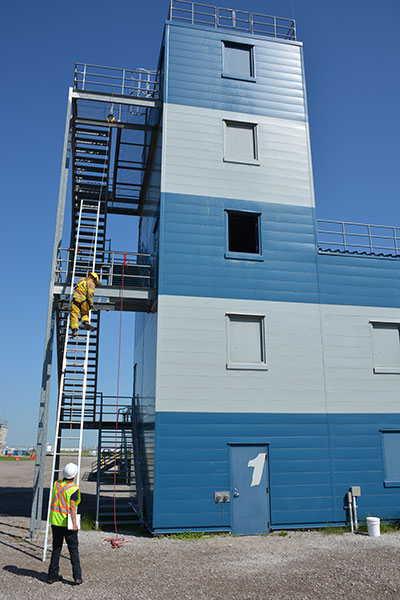 |
|
| Candidates pay about $800 for CTS testing – which includes firefighter skills ranging from knots to raising ladders; the goal of the program is to reduce costs for prospective firefighters, who have traditionally paid between $1,500 and $5,000 to apply to multiple municipal departments before getting hired. Photos by Laura King. |
It took three years of perseverance, a fair bit of frustration, and a lot of coaching to get hired – which is the norm for career firefighters in medium to large Canadian municipalities.
Fire chiefs in Ontario want to change the system – particularly the costs and the lack of preparedness – and, through the Ontario Association of Fire Chiefs new Candidate Testing Service (CTS), are trying to save prospective firefighters time, money and aggravation while streamlining the hiring process for municipal human resources departments.
“I meet a lot of candidates who think it’s going to be easy,” said Holmberg, a FireFit competitor and CrossFit enthusiast. “It’s frustrating to see the lack of effort of some graduates.”
Holmberg did her firefighter training online through TrainingDivision.com, then a 21-day boot camp in Texas. Physically, she knew she was firefighter material; her challenge was the aptitude test – although she did OK on the tests, she couldn’t get that elusive 90-plus per cent that many municipalities require.
“I couldn’t score in high 90s,” Holmberg said in an interview. “For me, it was do every test that was out there, and I would sit in my car afterwards and remember the questions and try to memorize them for the next time.”
That arbitrary high-90s mark – or whatever value is chosen by municipal human resources departments as the pass mark – can be problematic if candidates choose to challenge its validity.
Arbitrary numbers are sometimes not defensible under human rights legislation and some municipalities have been – and are being – challenged by candidates who score less than the mark set by the municipality. What’s to say, for example, that a candidate who scores 94 per cent is less qualified than an applicant who scores the required 95 per cent?
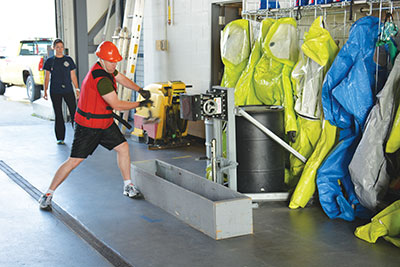 |
|
| A firefighter candidate moves through the CPAT test at the Fire and Emergency Services Institute (FESTI), located at the Greater Toronto Airport Authority. FESTI was chosen by Ontario Fire Administration Inc. to host its Candidate Testing Service.
|
CTS manager Michelle O’Hara says that’s why candidates who write the new standardized test pass or fail but are not given a numerical score. Marks are based on a different “bands” developed by Fire and Police Selection Inc., the vendor that created the aptitude, interpersonal and work-styles test for CTS. The passing grade – or band – was chosen by the CTS advisory board, which comprises fire officers and human resources managers from departments that have signed on to the standardized testing system.
“The aptitude testing previously didn’t have the interpersonal skills and work styles,” O’Hara said, “so candidates could score really well on map reading and other things; that doesn’t determine that they’re the best fit for the job.”
O’Hara said Fire and Police Selection Inc. did a two-year study of physical, interpersonal and work styles to determine the skills needed for the job.
“Our validation of human skills and work-styles inventory is all based on the criteria to be a firefighter. The majority of the standard is Grade 12-plus. The studies were based on the role of the firefighter – map reading, mathematical reasoning, whether you can read instructions, your grammar – can you write reports, navigate the fire-truck through the streets?
“That’s why we put some value in the work-styles inventory and the personality testing – because that’s going to tell you whether people can get along in their departments, work well in their communities and work as a team. It’s not jut about whether you can do a mathematical calculation.”
The other problem, O’Hara said, with the arbitrary pass mark is that even the physical testing portion is rated.
“So, basically, some people who take the aptitude and CPAT get ranked first through 20th, so you’ll have 20 candidates at 80.117 or 80.226, and how do you determine who are the best candidates without interviewing them? In some respects the aptitude test really doesn’t say if they’re the right fit for the job, it just means they’re book smart.”
Which is exactly what Holmberg experienced.
“The aptitude test – reading comprehension and math – the math took me a lot of time and the test has a time cap,” Holmberg said.
“A lot of the time the best firefighters are the ones that aren’t very book smart, they’re more hands on, so now there’s more of a hands-on component; once I got through the written part then I knew I’d breeze through the hands on.”
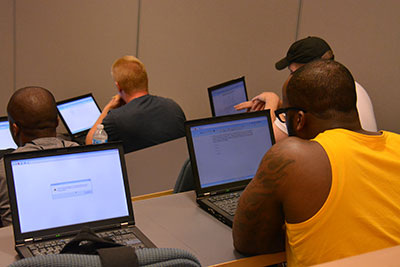 |
|
| Prospective firefighter recruits who have registered with Ontario’s new Candidate Testing Service complete the aptitude, interpersonal skills and work styles tests. Candidates who pass that group of tests move on to the CPAT, medical testing and firefighter technical skills.
|
In addition to testing and re-testing to improve her scores on the aptitude tests, Holmberg tutored kids in math to keep her skills sharp, volunteered with St. John Ambulance to become more proficient at the medical requirements, took a high-angle rescue course to get more experience with ropes and ladders, and got on with a volunteer fire department to hone all those competencies.
“Then,” she said, “all of the sudden, the testing process becomes easier.”
Holmberg’s strategy – improving already-learned skills, building new ones, staying fit and knowing exactly what the tests involve and what physical traits are required (all the information is available on the CTS website at www.ofai.ca) – is exactly what Toronto Fire Services (TFS) encourages candidates to do to.
“If you know you are not 20/30 vision, go to an eye doctor and see if it can be corrected,” said TFS Division Chief David Sheen at one of 10 outreach sessions for prospective firefighters in the spring. “We want you to be successful.
“The VO2 max is the end of the clinical assessment,” Sheen said. “If you are not prepared to do it then do not enter the test pool. The CPAT orientation – if you haven’t dragged a dummy, this is your opportunity.”
Indeed, lots of prospective firefighters don’t find out until it’s too late – until they’ve paid (or their parents have paid) tens of thousands of dollars for college programs – that they lack the aptitude, interpersonal skills or physical prowess necessary to be a firefighter, or worse, that they’re colour blind, don’t meet the vision requirements, or have high blood pressure or a high resting heart rate, and are therefore ineligible to be hired until those conditions are corrected.
What’s more, as Holmberg can attest, the cost of applying to municipal fire departments (after paying all that money for a college program) and taking repeated CPAT tests – the certification expires after 12 months – can be prohibitive.
O’Hara says prospective firefighters typically spend between $1,500 and $5,000 applying to fire departments before they get hired. The system, she says, is flawed: it caters to those who can afford it and have already completed firefighter training programs at community colleges or other institutions – typically, Caucasian males – and there are few, if any, support systems in place. In addition, firefighter training programs – there are about 17 in Ontario alone – are cranking out hundreds of students each year for whom there simply aren’t enough jobs.
The OAFC launched CTS in April after being directed by its members – the province’s chief fire officers – to devise a system of standardized testing that is fair and accessible to all prospective firefighters, keeps costs down for candidates, and eliminates considerable administrative work for municipalities.
Prospective firefighters register online with CTS and choose testing times. The $800 fee includes the interpersonal skills testing – something most municipalities don’t do in their screening processes but which is a crucial component of a successful fire-service career, says CTS program manager Brad Bigrigg.
“Most problems that develop in the fire hall are people problems, not process problems,” Bigrigg said in an interview.
CTS also tests for work styles – how people get work done and their work habits – and firefighter technical skills, from raising and climbing ladders to ventilating a pitched roof, which is not a part of some municipal candidate-testing processes. Bigrigg says CTS also tests more vigorously for hearing and vision than many municipalities.
The testing is done at FESTI – the Fire and Emergency Services Training Institute at the Greater Toronto Airport Authority. FESTI was the successful bidder and has hired evaluators for each segment of the testing process.
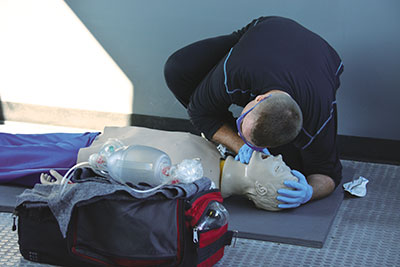 |
|
| A firefighter candidate moves through steps during the clinical testing portion of Ontario’s new standardized-testing program. Candidates who pass all levels of the test receive a certificate and can then apply to municipalities that have signed on with CTS. |
Candidates who pass the first group of tests – the aptitude, interpersonal and work styles – move on to the medical and clinical assessments and CPAT orientation (if they choose). Those who do not pass can re-test in 30 days. Those who pass the first set of tests go on to the CPAT and firefighter technical skills segments – the skills portion is based on NFPA standards. Candidates who pass all the tests can apply to municipalities that have signed on with CTS to select candidates to interview. There is no fee to apply to municipalities that have signed on to CTS.
Toronto was the first department to sign on to CTS. It wants its members to better reflect the city’s diverse population, and offers a career-access stream of testing to draw candidates from visible minorities.
Essentially, candidates who successfully complete the aptitude and interpersonal skills tests can defer the subsequent tests for up to two years while they complete their firefighter training. Candidates who complete the first level of testing – in other words, they know they have the aptitude, work habits and interpersonal skills that TFS requires – can apply to TFS and be interviewed. If the interview is successful, candidates are given a right-of-first-refusal letter, then do their firefighter training – while keeping up their health and fitness – and come back to TFS once their firefighter education is complete.
“We’re here to set you up for success,” said Sheen. “We’re here to find out if you’re a good fit for us and if we’re a good fit for you.”
Indeed, once candidates are put on the right-of-first-refusal list, the Fire Services Credit Union offers a line of credit of up to $25,000 for firefighter training, Sheen said.
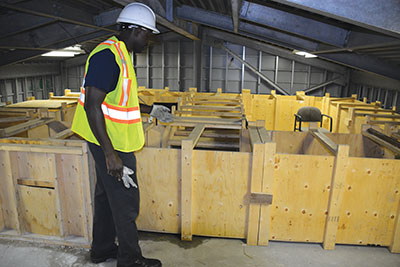 |
|
| An evaluator inspects the maze at the Fire and Emergency Services Training Institute in Toronto before prospective firefighter candidates run through the firefighter technical skills portion of the testing process.
|
Candidates who apply to Toronto and already have firefighter training go into a hiring pool once they have passed all the tests, and are chosen by lottery for interviews. Those chosen get a conditional job offer then must do a medical test and provide references. The interview, Sheen says, is crucial.
“We find candidates don’t answer the questions fully; listen, give the answer and relate it to personal experience.”
Kitchener Fire has also signed on to CTS. Tim Beckett, who was the fire chief in Kitchener but moved to Mississauga in late July, said the CTS testing is similar to what Kitchener had been doing but frees up valuable human resources time.
“The program also provides an improvement to the candidates,” Beckett said, “not having to pay out to individual departments every time they apply to be a firefighter. I see this as a win-win for the fire departments and the candidates that are seeking employment.”
Bigrigg said several other municipalities are finalizing legalities and are expected to sign on with CTS shortly. The goal, he said, is to simplify the process for candidates, reduce overall costs and, most importantly, ensure an open, fair and defensible process that guarantees that appropriate candidates move through the process for interviews with fire departments.
But not everyone has bought into CTS – yet. OAFC executive director Richard Boyes said that while a motion to establish a candidate-testing system was passed at the 2012 mid-term meeting, CTS is working with fire departments and human resources managers across Ontario to draw municipalities into the program.
Municipalities that want to participate in CTS must sign an agreement with Ontario Fire Administration Inc. under which they take applications only from candidates who are CTS certified; CTS will let successful candidates know by email when departments are recruiting.
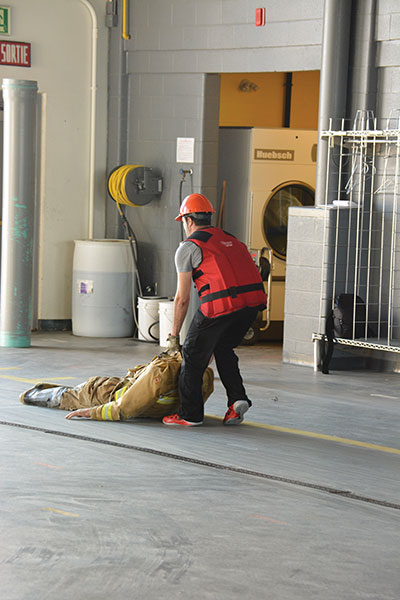 |
|
| A prospective firefighter pushes through the dummy drag as part of the candidate physical ability test. Candidates who pass the CPAT move on to clinical and technical-skills testing. |
Skeptics have said the OAFC has established CTS as a cash grab. Boyes counters that with the fact that all money from CTS goes back into the fire service, and notes that private candidate testing companies – which typically charge lower fees but also offer less vigorous testing – are for-profit entities.
On a breezy Thursday morning in late June, a male candidate being tested at FESTI failed the medical skills assessment; the scenario involved a conscious patient who was transitioning into unconsciousness.
O’Hara said about one in 10 candidates fails that segment of the testing and encourages prospective firefighters to brush up on medical-response skills before choosing a test time.
“All the information about the testing is available on our website, and there is lots of detail,” O’Hara said. “There’s no excuse for showing up unprepared. If you’re not ready, wait until you know you can pass the tests so that you set yourself up for success.”
TFS District Chief Ron Barrow, who is in charge of recruitment, is blunt but encouraging: he doesn’t want candidates who aren’t ready to pay money for testing.
“We want you to manage your application process,” Barrow told a room full of prospective candidates in Toronto in May. “We want you to do your research and do what’s best for you.”
Print this page